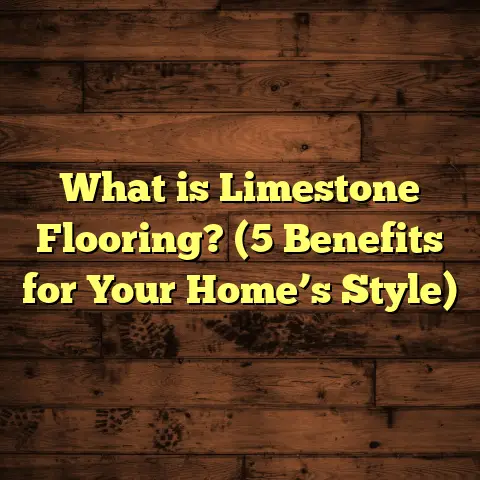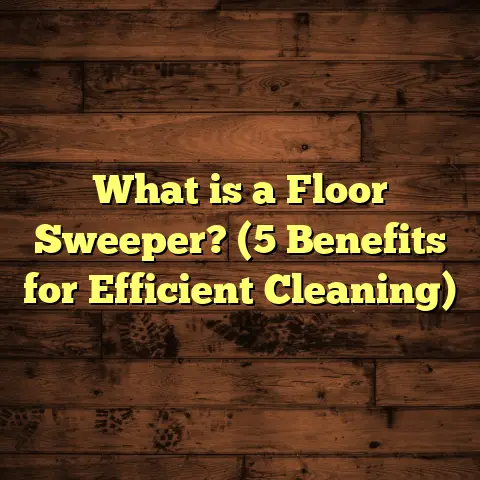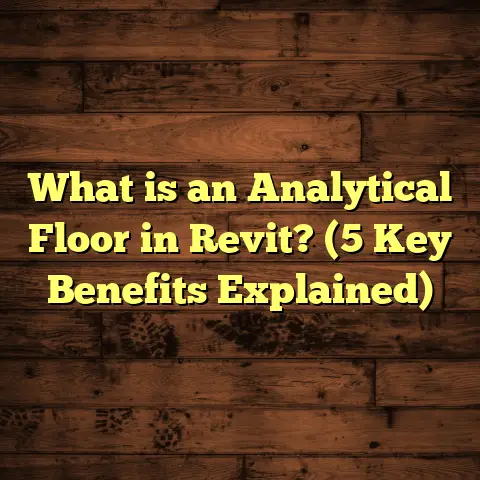What Is Vinyl Flooring Made Of? (5 Key Materials Explained)
Have you ever stopped to think about what exactly makes vinyl flooring so popular? I mean, it’s everywhere—from kitchens and bathrooms in homes to busy commercial spaces—and yet, many people don’t really understand what’s inside those vinyl planks or sheets that make them so durable and versatile. When I first started installing floors years ago, I assumed vinyl was just some cheap plastic. But as I got deeper into the trade, I realized there’s a whole science behind it. The materials combined to create vinyl flooring are carefully chosen and layered to deliver strength, flexibility, beauty, and affordability.
If you’re curious about what vinyl flooring is made of or considering it for your next project, I’m going to share everything I’ve learned over the years: the key materials, how they work together, installation tips, maintenance advice, and even some numbers and case studies to back it all up. Let’s get started.
What Is Vinyl Flooring?
At its core, vinyl flooring is a synthetic product made mainly from polyvinyl chloride (PVC) combined with other additives. It’s designed to mimic natural materials like wood, stone, or ceramic but at a fraction of the cost and with better resistance to moisture and wear.
Think of vinyl flooring as a multi-layered cake. Each layer has a particular job—from providing structure to giving it its look and protecting it from damage. The manufacturing process fuses these layers into sheets or planks that are easy to install and maintain.
I remember my first big vinyl flooring job—a kitchen renovation where the client wanted the look of hardwood but needed something waterproof and budget-friendly. We went with luxury vinyl planks (LVP), and seeing how well they held up over time was a game-changer for me. The floors still looked great years later, despite spills, dropped pots, and heavy foot traffic.
But what makes vinyl flooring tick? Let’s break down its five key materials.
1. Polyvinyl Chloride (PVC): The Core Ingredient
PVC is the backbone of vinyl flooring. It’s a synthetic plastic polymer made from vinyl chloride monomers that are polymerized into long chains. This material is strong, lightweight, and resistant to water and chemicals—making it perfect for floors that need to endure everyday use.
Why PVC?
PVC provides several benefits:
- Durability: It withstands heavy foot traffic without cracking or breaking.
- Water Resistance: Unlike wood or laminate, PVC doesn’t absorb moisture.
- Flexibility: When blended with additives, it can flex without damage.
- Cost-Effectiveness: PVC is relatively inexpensive compared to natural materials.
In my early days as a contractor, I often encountered clients concerned about their floors warping or swelling in damp areas. Vinyl with a solid PVC base proved to be a reliable solution every time.
How PVC Is Made
PVC production involves polymerizing vinyl chloride gas under controlled conditions. The resulting resin is a white powder that can be melted and formed into sheets or mixed with other substances before shaping.
The quality of PVC used matters a lot. For example, higher-grade PVC with fewer impurities results in longer-lasting floors. A 2023 industry analysis showed that premium vinyl flooring uses PVC with molecular weights optimized for flexibility and strength.
2. Plasticizers: Giving Vinyl Its Flexibility
If you’ve ever touched vinyl flooring and noticed it feels soft or slightly springy underfoot, that’s thanks to plasticizers. These are additives mixed into the PVC during manufacturing to make the material pliable rather than rigid.
Without plasticizers, PVC would be brittle and break easily when bent or walked on regularly.
Types of Plasticizers
There are two main categories:
- Phthalates: Traditional plasticizers widely used in the past but now under scrutiny due to health concerns.
- Non-phthalate plasticizers: Newer, safer alternatives that manufacturers use today.
In my experience working with suppliers over the years, I’ve seen a clear shift toward non-phthalate plasticizers for residential projects due to tighter regulations and consumer demand.
Why Plasticizers Matter
They:
- Improve flexibility so floors can handle temperature changes without cracking.
- Absorb impact to reduce damage from dropped objects.
- Enhance comfort for standing or walking long periods.
I once installed vinyl flooring in a cold basement where cheap plasticizers made the floor brittle during winter months. It cracked within months. That taught me to always specify quality plasticizers when ordering materials.
3. Stabilizers: Protection Against Heat and UV
Stabilizers are chemicals added to vinyl compounds to keep the material stable under heat, sunlight, or chemical exposure. Think of them as bodyguards for the PVC—they prevent breakdown that would cause color fading, brittleness, or loss of structural integrity.
Types of Stabilizers
- Lead-based stabilizers: Effective but mostly phased out due to toxicity.
- Calcium-zinc stabilizers: Environmentally friendly and commonly used today.
- Organic stabilizers: Used for specialized products requiring extra durability.
From my work on commercial projects with large windows or skylights, I’ve noticed floors without proper stabilizers fade much faster. One retail store I worked with replaced their vinyl after only three years due to sun damage; a costly lesson.
Benefits of Stabilizers
- Prevent discoloration from UV rays.
- Help floors resist heat damage during cleaning or sunlight exposure.
- Extend overall lifespan of the flooring product.
4. Fillers: Adding Bulk Without Breaking The Bank
Fillers are inert materials like calcium carbonate or clay added during manufacturing to bulk up the product while reducing costs.
Why Are Fillers Used?
Fillers can make up 30-50% of some vinyl flooring formulas. They add weight and volume without adding expensive PVC resin.
However, too many fillers can reduce flexibility and durability. So balancing filler content is critical.
In my conversations with manufacturers, I learned that premium vinyl products tend to have lower filler percentages (~20%) for better performance, while budget options push fillers higher.
Effects on Quality
- High fillers can make floors stiff and prone to cracking.
- Too little filler means higher costs but better flexibility.
- Properly balanced fillers maintain strength while keeping prices competitive.
5. Wear Layer: The Invisible Armor
The wear layer is the topmost transparent coating on vinyl flooring that protects the printed design beneath from scratches, stains, and fading.
This layer is made from urethane or aluminum oxide-enhanced coatings depending on quality.
Why Is The Wear Layer Important?
It defines how well your floor stands up over time, especially in high-traffic areas.
In residential floors, wear layers usually range from 6 mils (thousandths of an inch) to 12 mils thick. Commercial floors can have 20 mils or more for extra durability.
I remember helping a client choose between two vinyl products—one with an 8 mil wear layer and another with 12 mils. We went with the thicker layer after discussing how pets and kids would likely scratch the floor over time. That decision saved them money on repairs down the line.
How Wear Layers Are Tested
Manufacturers test wear layers using abrasion machines simulating years of foot traffic. A study by the Resilient Floor Covering Institute (RFCI) found that floors with wear layers over 12 mils lasted twice as long in commercial settings compared to thinner ones.
Putting It All Together: How Vinyl Flooring Is Manufactured
Now that we know the main ingredients, let’s look at how they come together in the production process:
- Backing Layer: Usually fiberglass matting or felt that adds dimensional stability.
- Core Layer: Made from PVC mixed with plasticizers, stabilizers, fillers.
- Design Layer: A high-quality printed film that replicates natural patterns like wood grain or stone textures.
- Wear Layer: Clear protective coating applied on top.
- Optional Coatings: Sometimes ceramic beads or antimicrobial treatments are added for scratch resistance or hygiene.
These layers are fused via heat pressing or calendaring (rolling) into sheets or planks ready for packaging.
My Personal Experiences: Installing Vinyl Flooring in Different Settings
Over more than a decade working as a flooring contractor, I’ve installed vinyl flooring in all kinds of environments—homes, offices, retail shops, even medical clinics.
Kitchens & Bathrooms
I often recommend vinyl here because it handles moisture well. One client had constant water drips near their sink but never saw any damage to their luxury vinyl plank floor even after three years.
Basements & Laundry Rooms
Vinyl’s resistance to humidity makes it ideal in basements where wood floors would warp. In one project, we installed sheet vinyl glued down tightly over a concrete slab with no issues for over five years despite occasional basement dampness.
Commercial Spaces
Retail stores and offices benefit from commercial-grade vinyl with thick wear layers and stabilizers that resist fading under bright lights. One store owner told me their floors still looked great after heavy foot traffic for seven years—much longer than previous laminate floors they had installed.
Installation Basics: Getting Vinyl Floors Right
Installing vinyl flooring depends on the type you choose:
Sheet Vinyl
Often glued down fully over the subfloor. It requires smooth surfaces without bumps or debris for best results. Good for large areas like basements or kitchens where seams are minimal.
Luxury Vinyl Planks (LVP)
Vinyl Tiles
Similar installation methods as LVP but square-shaped tiles give more layout flexibility.
Tips From My Experience:
- Prepare Subfloor First: Clean, dry, level surfaces prevent issues later.
- Use Underlayment When Recommended: Adds cushioning and sound absorption.
- Allow Expansion Gaps: Prevent buckling as materials expand/contract.
- Acclimate Materials: Let vinyl sit in room temperature before installing.
In one project installing LVP in a condo unit last summer, skipping acclimation caused the floor to buckle slightly after installation because temperature differences weren’t accounted for—a mistake we corrected by reinstalling after proper acclimation.
Maintenance That Keeps Vinyl Looking Great
Vinyl is known for being low-maintenance but following some simple steps can prolong its life:
- Sweep or vacuum regularly to remove dirt that causes scratches.
- Mop with mild cleaners; avoid harsh chemicals or abrasive scrubbers.
- Wipe spills quickly especially oils or dyes.
One restaurant client I worked with implemented a daily cleaning routine using recommended solutions and saw their vinyl stay intact for over 10 years—a huge savings compared to replacing worn-out tile floors every few years.
Some Data To Consider About Vinyl Flooring
- Vinyl flooring currently makes up roughly 30% of resilient flooring sales in North America (Resilient Floor Covering Institute 2024 data).
- Average lifespan ranges between 10-20 years depending on product quality and care.
- Cost varies widely: $2–$7 per square foot installed depending on type (sheet vs plank), wear layer thickness, labor rates (FloorTally estimates).
According to a 2023 consumer satisfaction survey by Home Flooring Insights:
- 85% of homeowners were satisfied with their vinyl flooring for durability.
- 78% appreciated its ease of cleaning.
- Major complaints were related to improper installation or choosing low-quality products.
Case Study: Vinyl Flooring in a Family Home With Pets
A family I worked with recently wanted durable floors that could survive dogs running around without constant scratches or stains. We selected luxury vinyl plank flooring with a 12 mil wear layer enhanced by ceramic beads for extra scratch resistance.
Two years later:
- The floors showed only minor surface marks easily cleaned off.
- No signs of warping despite wet paws tracking mud inside.
- The family loved how warm it felt compared to tile.
This real-world example highlights how material choices affect performance based on lifestyle needs.
Environmental Considerations: Is Vinyl Flooring Sustainable?
You might be wondering if vinyl flooring is eco-friendly. PVC production involves fossil fuels and chemicals that raise environmental concerns.
However:
- Many manufacturers now produce low-VOC (volatile organic compound) vinyl products improving indoor air quality.
- Some brands recycle post-consumer vinyl into new flooring products.
- Innovations in bio-based plasticizers are emerging.
It’s worth asking your supplier about sustainability certifications like FloorScore or GREENGUARD if indoor air quality matters to you.
Final Thoughts From My Years On The Job
Vinyl flooring combines multiple materials—PVC resin, plasticizers, stabilizers, fillers, and wear layers—each playing an essential role in making floors flexible, durable, attractive, and affordable.
Knowing what goes into your floor helps you:
- Choose the right product for your space,
- Understand installation requirements,
- Maintain it properly,
- And get better value long-term.
If you’re looking for practical advice tailored to your home or business needs—or want help estimating costs using tools like FloorTally—feel free to reach out anytime. I’m happy to share my experience so you get floors you’ll love walking on every day!
Would you like me to help you compare different vinyl products based on material composition? Or maybe tips on troubleshooting common installation problems? Just let me know!





